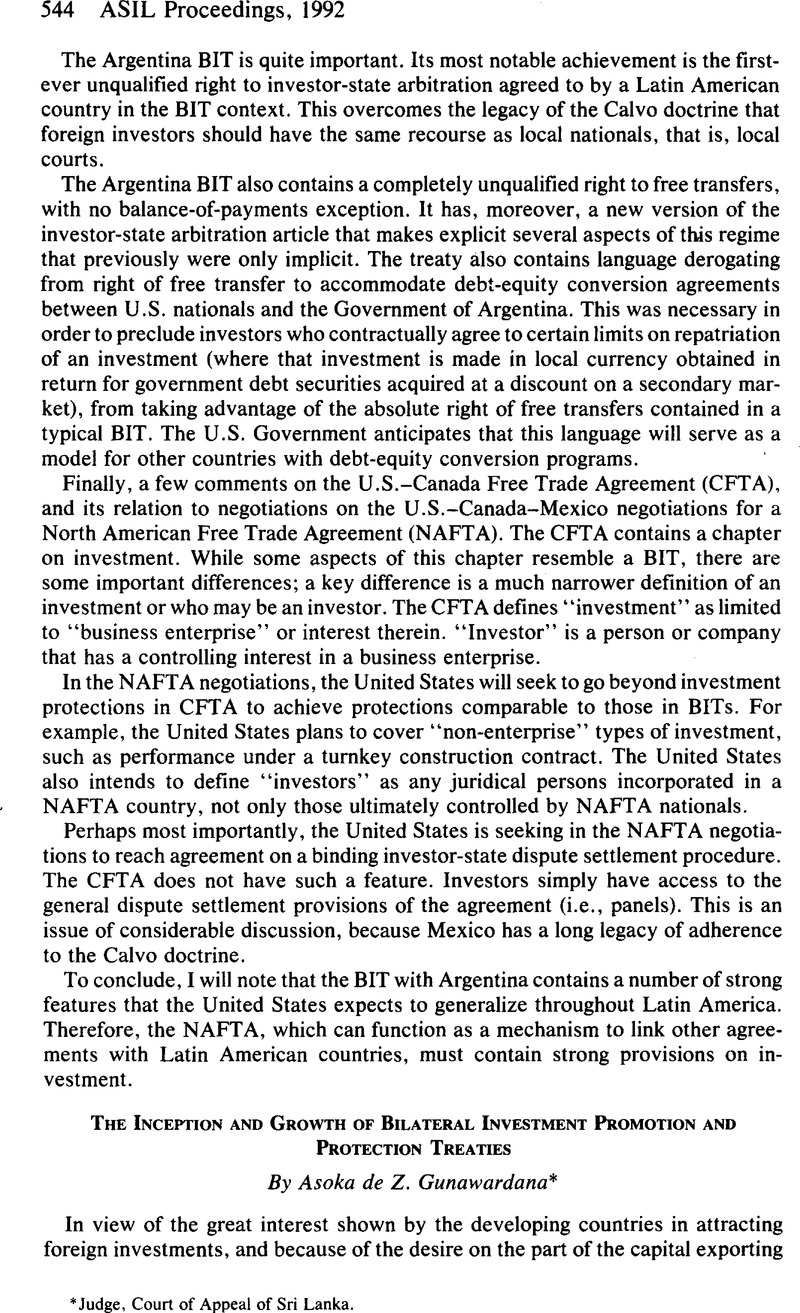No CrossRef data available.
Article contents
The Inception and Growth of Bilateral Investment Promotion and Protection Treaties
Published online by Cambridge University Press: 28 February 2017
Abstract

- Type
- Other
- Information
- Copyright
- Copyright © American Society of International Law 1988
References
1 For a detailed survey through February 22, 1991, see 30 ILM 252-59 (1991).
2 “Agreements Providing for the Promotion and Protection of Private Foreign Investments in Developing Countries.” UN Department of Economic and Social Affairs, Foreign Investment in Developing Countries, UN Doc. E/446 (1968) at 61.
3 UN Centre on Transnational Corporations, Bilateral Investment Treaties, at 90-91, UN Doc. ST/CTC/65, UN Sales No. 88.11.A.1 (1988).
4 Id. at 123-31.
5 U.S. Policy on Foreign Direct Investment, White House Fact Sheet, at 400 (EPF 503, 12/27/91).
6 30 ILM 252-59 (1991).
7 Supra note 3, at 6.
8 Id.
9 Id. at 8.
10 The countries with which Sri Lanka has signed such treaties are, the UK, the Republic of Korea, France, Singapore, Romania, Switzerland, Japan, Sweden, the Belgo-Luxemburg, the Netherlands, Denmark, Finland, Norway, the People’s Republic of China, Italy and the United States. There are also investment protection agreements entered into with West Germany in 1960 and with Canada in 1982 that are still in force. The latest treaties, with the United States and Italy, have not gone through the constitutional process.
11 The Constitution of the Democratic Socialist Republic of Sri Lanka. Legislative Enactments of the Democratic Socialist Republic of Sri Lanka, Vol. 1, chapter 1, p. 52 (Article 157): Where Parliament by resolution passed by not less than two-thirds of the whole number of Members of Parliament (including those not present) voting in its favour approves as being essential for the development of the national economy, any Treaty or Agreement between the Government of Sri Lanka and the Government of any foreign State for the promotion and protection of the investments in Sri Lanka of such foreign State, its nationals, or of corporations, companies and other associations incorporated or constituted under its laws, such Treaty or Agreement shall have the force of law in Sri Lanka, and otherwise than in the interests of national security no written law shall be enacted or made, and no executive or administrative action shall be taken, in contravention of the provisions of such Treaty of Agreement.
12 Supra note 9.
13 Supra note 3, at 19.
14 These resolutions are (1) GA Res. 3201 (S-VI), Declaration on the Establishment of a New International Economic Order (May 1, 1974); (2) GA Res. 3202 (S-VII), Programme of Action on the Establishment of a New International Economic Order (May 1, 1974); and (3) GA Res. 3281 (XXIX), Charter of Economic Rights and Duties of States (CERDS) (December 12, 1974). See also lectures given by Professor D. H. N. Johnson on Air and Outer Space Law and the NIEO to the Institute of Public International Law and International Relations, Thessaloniki, Greece, September 1979. See Thesaurus Acroasium, Vol. X, pp. 383-450.
15 Agreement Between the Government of the Democratic Socialist Republic of Sri Lanka and the Government of the United Kingdom of Great Britain and Northern Ireland for the Promotion and Protection of Investments (1980).
16 “Fair Market Value: The price a willing buyer would pay a willing seller in circumstances in which each had good information, each deserved to maximise his financial gain and neither was under duress or threat, the willing buyer being a reasonable businessman.” (See also the Starrett Housing Corp. case [Iran-U.S. Claims Tribunal Rep., Vol. 16 (1987)].) It is to be noted that there are, nevertheless, questions as to what market is to be used, if, indeed, there is a market, and whether the willing buyer is always a stereotype who will use a particular standard valuation.” C. F. Amerasinghe, Issues of Compensation for the Taking of Alien Property in the Light of Recent Cases and Practice, 41 Int’l & Comp. L. Q. 22, 51 note 1 (1992).
17 Supra note 3, at 125.
18 UN Doc. A/PV 2229-2231. See also 13 1LM 744-49, 759, 762 (1974). For the background to these resolutions, see Juha Kuusi, The Host State and Transnational Corporations 129 et seq. (1979).
19 Supra note 3, at 8.
20 Oscar Schachter, Compensation for Expropriation, Editorial Comment, 78 AJ1L 121 (1984). For a critical or contrary view regarding the custom-forming theory, see Davis R. Robinson, Expropriation in the Restatement (Revised), Notes and Comments, 78 AJIL 176 (1984). See also C. F. Amerasinghe, supra note 16, at 30.
21 Jurgen Voss, The Protection and Promotion of European Private Investment in Developing Countries: An Approach towards a Concept for a European Policy on Foreign Investment, 18 Common Mkt. L. Rev. 369 (1981). The author concludes as follows: “While systematically reducing investmentprotection under international law at multilateral level, they restore it bilaterally by means of international agreements. The explanation of this phenomenon is that each guarantee of investment protection under international law requires a developing country to weigh up ideological interests related to sovereignty and the desire for economic growth, these conflicting interests carrying different weight at bilateral and multilateral levels.”




